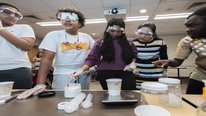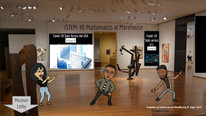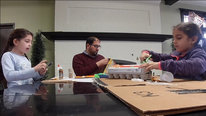- David Jackson
- https://www.linkedin.com/in/jacksondw/
- Doctoral Candidate + After-school STEM Coordinator
- Presenter’s NSFRESOURCECENTERS
- Boston College, Waltham Public Schools
- Christian Asante
- PhD Student
- Presenter’s NSFRESOURCECENTERS
- Boston College
- Mike Barnett
- http://iuse.bc.edu
- Professor of Science Education and Technology
- Presenter’s NSFRESOURCECENTERS
- Boston College
- Meghan Broadstone
- https://www.edc.org/staff/meghan-broadstone
- Research Scientist
- Presenter’s NSFRESOURCECENTERS
- Education Development Center
- Yihong Cheng
- Graduate Student
- Presenter’s NSFRESOURCECENTERS
- Boston College
- Rajeev Rupani
- Senior Research Associate
- Presenter’s NSFRESOURCECENTERS
- Boston College
- Kelsey Tayne
- Research Associate
- Presenter’s NSFRESOURCECENTERS
- University of Colorado Boulder
- Helen Zhang
- Senior Research Associate
- Presenter’s NSFRESOURCECENTERS
- Boston College
Interdisciplinary Approaches to Teaching Computational Environmental Science
2021 (see original presentation & discussion)
Grades 6-8, Grades 9-12
This project targets an urgent need for real-world, interdisciplinary, and computational preparation of middle and high school students. Most schools that serve low-income youth are under pressure to get through certain science concepts to prepare their students for standardized testing, which means that the teaching of skills and knowledge around automation is highly unlikely to occur, unless it is embedded in curriculum materials that meet the standards and content that teachers need to address. Furthermore, at the current time, most middle school science teachers have very little experience with coding and automation, and are far more comfortable with teaching about plants and ecosystems. As such, we have developed a suite of tools using low-cost microcontrollers, low-cost sensors, and through the use of MicroPython and MakeCode (through the use of BBC micro:bits). We share in this video how we adopted the materials and project work for implementation during the pandemic.
Through this project, youth also learn the importance and value of automating both the data collection and operation of their smart greenhouse, in which they can grow plants through the use of a new growing technique using transparent soil. Transparent soil, which is a hydrogel that behaves like soil, offers a unique opportunity for youth to see how roots grow in the real world because it mimics how roots grow in regular soil. This also engages them in the same type of scientific research that is occurring in research labs at the university level.
Related Content for Enabling Opportunity: Bridging Science & Physical Computing
-
 2020Blending Science, Coding, and Transparent Soil
2020Blending Science, Coding, and Transparent Soil
Mike Barnett
-
 2019Integrating STEM and Computer Science in High School
2019Integrating STEM and Computer Science in High School
Elizabeth Radday
-
 2021PrimaryAI: Integrating AI into Elementary Science using PBL
2021PrimaryAI: Integrating AI into Elementary Science using PBL
J. Adam Scribner
-
 2018Intertwining Coding with Standard Science Curricula
2018Intertwining Coding with Standard Science Curricula
Grace Flanagan-Hall
-
 2020Highlighting Science Practices in First Grade Classrooms
2020Highlighting Science Practices in First Grade Classrooms
Kevin Waterman
-
 2019Integrating Computational Thinking in Elementary Science
2019Integrating Computational Thinking in Elementary Science
Kevin Waterman
-
 2018Advancing STEM: Data Systems Inclusion in Student Learning
2018Advancing STEM: Data Systems Inclusion in Student Learning
Betsy Stefany
-
 2019The STEMcoding Project
2019The STEMcoding Project
Chris Orban
Playlist: ITEST Videos Playlist
-
 2021Socially-Distanced Community Conservation Partnerships
2021Socially-Distanced Community Conservation Partnerships
Nicole Freidenfelds
-
 2021CryptoComics - Cryptology and Cybersecurity for Kids
2021CryptoComics - Cryptology and Cybersecurity for Kids
Christine Wusylko
-
 2021Stories of Algebra for the Workplace
2021Stories of Algebra for the Workplace
Candace Walkington
-
 2021Empowering Students in Math Through Entrepreneurship
2021Empowering Students in Math Through Entrepreneurship
Erin Krupa
-
 2021Inventing Designing and Engineering for All Students
2021Inventing Designing and Engineering for All Students
Wendy Martin
-
 2021The Human Body in P6 STEM Teaching: The BODYMODELS Project
2021The Human Body in P6 STEM Teaching: The BODYMODELS Project
Neal Grandgenett
-
 2021Our Experiences with Game Based CRC, Esports, and the Future
2021Our Experiences with Game Based CRC, Esports, and the Future
Mark Van Auken
-
 2021iSTEM-Xe: Implications of COVID-19 on the Black Community
2021iSTEM-Xe: Implications of COVID-19 on the Black Community
Shannon Jolly
-
 2021Interest Stereotypes Cause Gender Gaps in STEM Motivation
2021Interest Stereotypes Cause Gender Gaps in STEM Motivation
Marley Jarvis
-
 2021Voices to Hear
2021Voices to Hear
Shakuntala Gopal
-
 2021Challenger Center Classroom Adventures
2021Challenger Center Classroom Adventures
Lance Bush
-
 2021Chief Science Officers Go Virtual
2021Chief Science Officers Go Virtual
Kelly Greene
-
 2021Billion Oyster Project Curriculum and Community Enterprise
2021Billion Oyster Project Curriculum and Community Enterprise
Dr. Lauren Birney
-
 2021Catalyzing Inclusive STEM Experiences: Tune in for Equity
2021Catalyzing Inclusive STEM Experiences: Tune in for Equity
Lara Hebert
-
 2021Super Fun Science of Music Hands-on Online Tools.
2021Super Fun Science of Music Hands-on Online Tools.
Victor Minces
-
 2021Impact of a Family-Community-University Engineering Project
2021Impact of a Family-Community-University Engineering Project
Amber Simpson
-
 2021SPIKEY-20: A Virtual Epidemic for Connecting with COVID-19
2021SPIKEY-20: A Virtual Epidemic for Connecting with COVID-19
Yasmin Kafai
-
 2021GaleForce: Girls Immersed in Robotics Learning Simulations
2021GaleForce: Girls Immersed in Robotics Learning Simulations
Beryl Hoffman
-
 2021My STEM Story: Students Explore Science Identities
2021My STEM Story: Students Explore Science Identities
Ed Madison
-
 2021COVID-Inspired Data Science for Youth
2021COVID-Inspired Data Science for Youth
Jan Mokros
-
 2021Engineering Design for Rural Middle School Students
2021Engineering Design for Rural Middle School Students
LaTricia Townsend
-
 2021SEBA: STEM Engagement Through Mentoring
2021SEBA: STEM Engagement Through Mentoring
Rick Greer
-
 2021Engineering WINS
2021Engineering WINS
Jacqueline Genovesi
-
 2021Developing Middle School Students' AI Literacy
2021Developing Middle School Students' AI Literacy
Helen Zhang
-
 2021Collaboration Dynamics and Culturally Responsive Teaching
2021Collaboration Dynamics and Culturally Responsive Teaching
Meredith Kier
-
 2021Sustaining a STEM Learning Ecosystem During a Pandemic
2021Sustaining a STEM Learning Ecosystem During a Pandemic
Denise Nacu
-
 2021Internships for Underrepresented Students Amid the Pandemic
2021Internships for Underrepresented Students Amid the Pandemic
Lynda Gayden
-
 2021Place-Based Data Literacy: Protecting the Platte
2021Place-Based Data Literacy: Protecting the Platte
Samantha Schall
-
 2021Embodied Coding in Augmented and Virtual Reality
2021Embodied Coding in Augmented and Virtual Reality
Ying Wu
-
 2021WeatherBlur: student initiated citizen science program
2021WeatherBlur: student initiated citizen science program
Rebecca Clark Uchenna
-
 2021Enabling Opportunity: Bridging Science & Physical Computing
2021Enabling Opportunity: Bridging Science & Physical Computing
David Jackson
-
 2021Helping States Plan to Teach AI in K-12
2021Helping States Plan to Teach AI in K-12
Christina Gardner-McCune
-
 2021RPPforCS: Research Practitioner Partnerships across K-12
2021RPPforCS: Research Practitioner Partnerships across K-12
Rebecca Zarch
-
 2021Keeping the focus on dimensions of quality math discourse
2021Keeping the focus on dimensions of quality math discourse
Paola Sztajn
-
 2021Building Community to Shape Emerging Technologies
2021Building Community to Shape Emerging Technologies
Judi Fusco








David Jackson
PhD Candidate & After-school STEM Coordinator
This project fosters more equitable participation in computing, through the breadth and depth afforded by tabletop “smart” (automated) greenhouses. Working with K-12 faculty and staff across disciplines (“co-advisors”), high-school youth as teachers and mentors (“counselors”), and middle-school youth as learners (“campers” or “students”), our project has become more accessible across learning modalities (in-person, remote, or hybrid), hardware platforms (now Chromebook-compatible), and software platforms (now browser-based). Over the past 15 months, we have trained over 20 faculty/staff remotely, and over 10 high-schoolers in-person and remotely. Based on their feedback, and that of middle-school youth, our project has increasingly leveraged various physical aspects of the greenhouse (light intensity and color; temperature; humidity; soil moisture) in ways that bridge human senses and electronic sensors, connecting science with physical computing.
The high-school counselors and faculty/staff co-advisors worked with 14 campers over February Vacation week, and we will soon work with 130 eighth-graders during the school day. We partner with Massachusetts public schools in Boston, Springfield, and Waltham, each of which are racially/ethnically, culturally, linguistically, and socioeconomically diverse. Professionals across a variety of disciplines (environmental science, chemistry, physics, literacy, special education, and early childhood education) have shared how the project relates to their professional lives. Furthermore, both professionals and youth have made deep connections with family traditions related to gardening/farming, cooking, and multi-/translingual learning. Finally, noted increases in student engagement and self-efficacy suggest that youth may be better positioned to use computation in their lives, for a variety of personal, professional, and civic opportunities.
For more details about this work, see our recently-published article in Connected Science Learning (free access) or the project resources PDF for this presentation. Also, we look forward to engaging in discussion via the comments section below!
Kimberly Elliott
PATRICK HONNER
Teacher
Hi-
This sounds like a project I’d love to do at home myself! Can you give some examples of some of the experiments and refinements that were made? What data did students decide to capture, and what did they do as a result?
Kimberly Elliott
David Jackson
PhD Candidate & After-school STEM Coordinator
Thanks for your comment! Please see my post below, as links didn't work in my direct reply.
patrick honner
David Jackson
PhD Candidate & After-school STEM Coordinator
Hi Patrick (and all) -- links didn't work when I replied, so I'm making a new post here. In terms of experiments, students have manipulated the species of plants (basil, cilantro, various lettuces, assorted microgreens, etc.), colors of light (proportions of reds vs. blues, mostly), thresholds of high/low temperature or high/low humidity (lower temps for lettuces, higher temps for herbs, *in general*). Those data are used to automatically control whether lights are on or off, whether windows are opened or closed, and whether circulating and exhaust fans are on or off. Also, sometimes the LED strips are used for signaling purposes (rather than for plant growth) -- e.g., red = too hot, blue = too cold, green = just right (temperature) / purple = too humid, orange = too dry, yellow = just right (humidity).
The main data they collect are related to temperature and humidity, as well as intensity of light, plus they have also done soil moisture at times. Soil moisture remains troublesome, as misplaced or corroded sensors sometimes result in flooding.
We have STL files available here, if you want to 3D-print the connectors and holders yourself. We also have instructional videos for assembly of the greenhouse and coding of the micro:bit. Finally, here is a materials list for everything we’re using with 8th graders this term -- of course you can use as little or as much of the electronics as you want (the greenhouse is decent without them, and much less expensive than commercially-available models).
Happy greenhouse-ing! :)
KRISTIE GUTIERREZ
Kimberly Elliott
patrick honner
PATRICK HONNER
Teacher
Thanks for the details, and for the links! I'll definitely take a closer look: it sounds like a fun and fascinating project.
Marion Usselman
Associate Director, and Principal Research Scientist
Thanks for a very interesting video. I am curious whether you thought the online professional development for teachers was as effective as a face-to-face session. There are clearly pros and cons to both versions, and I suspect that we will see many more online and hybrid versions in the future. What are your long-term plans for the teacher PD?
Mike Barnett
Professor of Science Education and Technology
We think it was just as effective, efficient is another matter but it wasn't that far off. What was valuable was that the teachers had time to experiment and play at their own time and own pace between the introduction of concept and how to code a sensor to get data and the next session. In many ways we found the teachers developed a better understanding of how to use the tools as they had a longer time to think about it and explore as opposed to an intense institute which is usually what we have done during the summer. The biggest challenge to the online environment was trouble shooting as sometimes it was just a loose wire or someone had just plugged a sensor into the wrong port and those type of problems can be quickly fixed if live instead of virtual.
We have been thinking about how to proceed but given our experience and that we have teachers scattered about the region we are likely to have some kind of online training and virtual experience.
Plus the development of the instructional videos have proven to be extremely useful across the board for both students and teachers.
Jessica Moon
This sounds like such a fun project and an amazing way to combine science and computer science! Experimentation is so important in both fields, and it's great that you were able to restructure things so students could still experiment at home, despite the pandemic.
Khyati Sanjana
Senior Manager
Empowering high school students to lead the work is a great asset to this program. I wonder if you have compared the advantages of training students vs. adult learners and how it impacts other students. If you have, has the effect diminished in the virtual setting?
Mike Barnett
Professor of Science Education and Technology
Not directly in this project, we have looked a lot at the impact on high school youth as mentors for their younger peers in our food justice work:
https://stemforall2021.videohall.com/presentati...
The findings from that work is what led us to take this approach when the schools closed as we were looking for ways to maintain the engagment of the high shcool youth who were participating and given the increases in confidence, efficacy, and purpose from the changemakers work we took that near-peer mentoring approach and applied to this project (we took the electronics and coding from this project and applied it to the changemaker projects). We do have plans to look at how the entire family may learn together as they participate in the project as our experience within our partner communities tells us that many of the families and adults have a great deal of experience and expertise around growing plants but little around electronics so will be looking at how different aspects of the work provides entry points for people at different stages of their life in the doing of science.
Khyati Sanjana
Senior Manager
Thank you Mike. Getting the entire family to work together seems like such a wonderful idea. I wonder if you can connect this work to community gardens and providing healthy options for food desserts.
Mike Barnett
Professor of Science Education and Technology
Yep, we have another project that is working on that: https://stemforall2021.videohall.com/presentati...
Shad Wachter
This sounds like a great project! Can this be scaled down to younger grades just learning about plant growth and development and beginning programmers? I am also interested in the data analysis aspect of the project. Do the students make changes to the greenhouse environment based upon the data that is collected by the raspberry pi, or is there a level of AI that automatically informs the young botanists what conditions to modify to obtain the desired plant growth?
Mike Barnett
Professor of Science Education and Technology
Yes, we have done this work at the elementary level (if you drop me a note I can send the curriculum link) to that, just don't have it handy right now. We have not done the programming with younger grades, but all about he plants at younger grades.
Yes, the data streams to a raspberry pi from the bits and then through google's API connects to google sheets. That is a programatic issue in that then one only needs to get one device behind a school's firewall instead of all the bits using something like a ESP8286 chip or something like that.
We have been thinking about the AI aspects of this and have started to play around with lower entry tools like Google teacheable machine, and basic robotics :). Not much worth sharing yet though.
Further posting is closed as the event has ended.